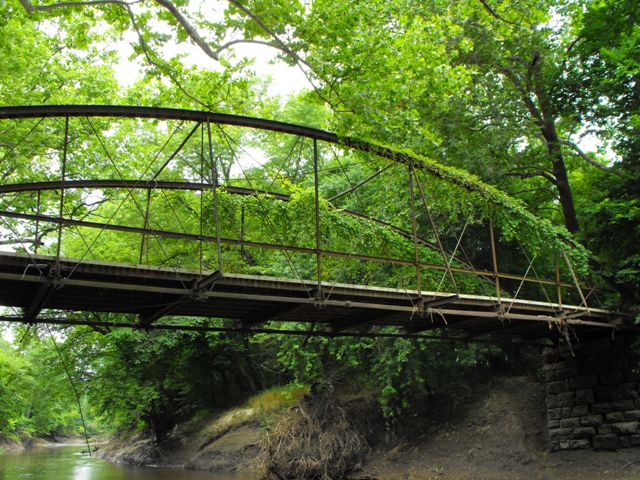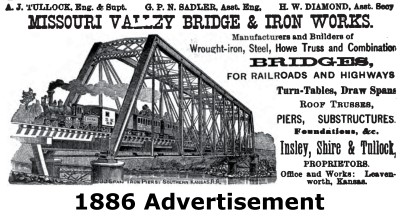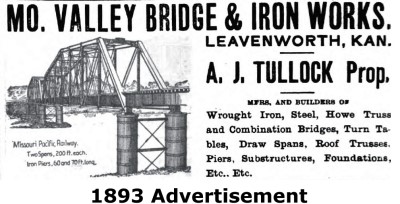We Recommend:
Bach Steel - Experts at historic truss bridge restoration.
BridgeHunter.com Phase 1 is released to the public! - Visit Now
Steel's Fishtrap Bridge
Norway Road Bridge

Primary Photographer(s): Nathan Holth and Rick McOmber
Bridge Documented: July 3, 2009
Rural: Saline County, Missouri: United States
1882 By Builder/Contractor: Missouri Valley Bridge and Iron Company of Leavenworth, Kansas
Not Available or Not Applicable
100.0 Feet (30.5 Meters)
100.0 Feet (30.5 Meters)
14 Feet (4.27 Meters)
1 Main Span(s)
22330

View Information About HSR Ratings
Bridge Documentation
View Archived National Bridge Inventory Report - Has Additional Details and Evaluation
Bowstring truss bridges are sometimes called bowstring arch bridges because they have similarities to both structure types. Beginning with Squire Whipple's Whipple Arch Bridges, such as the Ehrmentraut Farm Bridge, the bowstring truss bridge is the bridge type that began a transition away from wood and stone and began to make metal a common bridge building material. It also began a period of experimentation until a good bridge form was developed, leading to a gradual standardization of bridge design. During this period, numerous bridge companies all experimented with metal, trying to design the best bridge. Each company had their own distinctive bowstring design, including unique and creative design details. These designs were often patented. Most bowstring truss bridges were built in the 1870s. Also during this time, cast iron was still used in addition to wrought iron for the construction of bridges, so many bowstrings built during this period include details such as connection assemblies that are made of cast iron. By the 1880s, bridge companies decided that the pin-connected Pratt truss was a better structure type, and construction of bowstring bridges sharply dropped after 1880. It is imperative that each surviving bowstring in the county be preserved to protect this key period in bridge building history.
Most surviving bowstring truss bridges were built by the Wrought Iron Bridge Company, King Bridge Company, and Massillon Bridge Company, in that order. The number of bowstring truss bridges remaining built by large bridge companies is very small; the small number remaining from smaller bridge companies is even more dramatic. Surviving bowstrings built by other bridge companies may be the last of their builder's work.
The Steel's Fishtrap Bridge is indeed a rare example of a surviving bridge built by a company that was much less prolific with its bowstring truss bridge construction. Although with an 1882 construction date it is a later example of a bowstring, the bridge still conveys accurate and detailed information about the forms of the bridge type and the company that built it. It is interesting to note that the founder of Missouri Valley Bridge and Iron Company was Edwin Farnsworth, who had previously been employed as an agent for the both the King Bridge Company and the Wrought Iron Bridge Company before deciding the create his own bridge building company. Interestingly, the Missouri Valley Bridge and Iron Company seems to draw on the designs of King Bridge Company and Wrought Iron Bridge Company. The top chord is similar to the Wrought Iron Bridge Company's channel version of a bowstring top chord, while the pole/pipe sway bracing is strikingly similar... indeed nearly identical to... the King Bridge Company's sway bracing. Perhaps Farnsworth "borrowed" some of the ideas that his former employers had come up with.
The Steel's Fishtrap Bridge retains excellent historic integrity and has not been seriously altered.
The preservation of each surviving example is essential to maintain a comprehensive understanding of the level of engineering and design experimentation that was going on during the bowstring period.
This bridge should be preserved, either in place or at a new location, for either light vehicular or non-vehicular traffic, at all costs. This bridge should receive very high preservation priority.
While it may offer some opportunities for artistic photography, the vines growing on the bridge should be removed for the sake of maintaining the structural integrity of the bridge.
Information and Findings From Missouri's Historic Bridge InventoryBridge Features
Superstructure: wrought iron, 10-panel,
bolt-connected bowstring through arch-truss Discussion of Bridge Lacking the funds to build permanent bridges over larger rivers such as the Salt Fork and Blackwater, Saline County in its formative years licensed the operation of toll ferries during the 1820s, 1830s and 1840s. The Arrow Rock ferry across the Missouri River was clearly the region's earliest. Established in 1817 as the first ferry across the Missouri west of Franklin, it proved pivotal in the routing of the Santa Fe Trail through the county. In 1833 the county court authorized Richard Marshall to operate a ferry across the Blackwater at the mouth of Salt Fork. Other ferries and fords, notably the Hunt's Ferry across the Blackwater and the Jonesboro Ferry across Salt Fork, developed with need. By the 1840s, however, it had become apparent that the ferries made poor river crossings and that permanent bridges were necessary for the developing road system. In May 1843 the court authorized construction of the county's first major bridge over the Salt Fork at Jonesboro. Completed two years later, the timber span lacked a wooden sheathing to protect the structural members. Leaving the superstructure exposed did not pose a serious threat to the small-scale timber pile spans, which rarely lasted long enough to suffer damage by rain and snow. But more complex and expensive timber trusses, left open to the weather, proved vulnerable to deterioration in their chord connections. The Jonesboro Bridge lasted only nine years before it needed replacement. For this reason, the county began covering its wooden trusses with shingle roofs and plank siding in the early 1850s. Structures such as the new Jonesboro Bridge [1854] and Kiser Bridge [1854] over Salt Fork and the Napton Bridge [1855] and Marshall Bridge [1856] over the Blackwater featured timber/iron Howe truss superstructures with wood housings. Throughout the 1850s and 1860s, Saline County built only timber and timber/iron combination bridges at the major crossings. In the early 1870s, however, the court began contracting for all-iron structures as a more durable alternative to wood construction. Two of these earliest iron trusses were an 80-foot span across Salt Fork at Walker's Ford and a 60-foot span across Salt Fork on the Marshall- Miami Road, both erected in 1875 by Farnsworth and Eaves of Kansas City. In the early 1880s the county began replacing some of its earliest covered bridges with iron spans. The Steel's Fish Trap Bridge is one of these replacement structures. The original bridge at this crossing southeast of Marshall was built in 1875. That February the Saline County Court appropriated funds, in the amount of $1600.00, to build a bridge across the Salt Fork Creek at Steel's Trap, as petitioned by G.A. Munel and others. The court at that time appointed the county road commissioner to prepare the plans and specifications for the structure. The bridge contract was awarded a month later to W.L. Smiley for $1550.00. After construction was underway in August, George W. Latimer, the Saline County Bridge Commissioner, reported to the road and bridge commission that "a portion of the masonry (fell) short of specs in some unimportant particulars." Nonetheless, the court accepted the bridge as complete, paying Smiley $1507.50 for the masonry work and $1550.00 for the combination truss superstructure. It is not known whether the original bridge here was sheathed with siding. Seven years after its completion, the county began planning for its replacement-an indicator of either calamity or poor construction. The Missouri Valley Bridge and Iron Company of Leavenworth, Kansas, placed an $880.00 bid in October 1882 to erect the replacement superstructure: a 100-foot wrought iron bowstring arch-truss using the firm's patented configuration. Since its 1882 completion, the Steel's Fish Trap Bridge continues to carry traffic in essentially unaltered condition. The bowstring arch-truss was the iron span of choice for Missouri counties in the late 1860s and 1870s. Marketed extensively throughout the Midwest by such industry giants as the King Iron Bridge and Manufacturing Company, the Wrought Iron Bridge Company and the Missouri Valley Bridge and Iron Company, these often-patented bridge forms featured a wide range of span lengths, economical fabrication cost and relatively quick erection. The proliferation of the bowstring corresponded with the initial development of Missouri's road system. As a result, perhaps thousands of these prototypical iron spans were erected throughout the state. The bowstring had some rather severe structural flaws, however, relating primarily to lateral stability of the arches, and it was largely superseded by the pin-connected truss in the early 1880s. Despite this, some bowstrings were still erected in Missouri in the 1880s, although the number dwindled precipitously by the decade's end. Through subsequent attrition, almost all of Missouri's bowstrings have since been replaced and demolished. Now only a half-dozen remain in place. With its excellent degree of physical integrity, the Steel's Fish Creek Bridge is both historically and technologically significant as one of the last remaining examples in the state of what was once a mainstay structural type. Bridge Considered Historic By Survey: Yes |
History of Missouri Valley Bridge and Iron Company From Historic American Engineering RecordCompany Overview The Missouri Valley Bridge and Iron works was located in Leavenworth, Kansas. The company likely built many bridges in Missouri, Kansas and Nebraska. Apparently the company began operating in 1876. Jasper County Court records indicate that the firm built five bridges in the county between 1881 and 1891, including the American Mill Bridge. Three of the five in Jasper County remain standing; two are in use today. In southern Missouri, the company also built bridges in Barton County, Vernon County, and Phelps County. The bridge in Phelps County was built in 1911. This indicates that the company was apparently in operation from 1876 to at least 1911. Insley, Shire and Tullock were the proprietors of the company in the mid 1880's. A. J. Tullock was listed as the sole proprietor in 1890. The annual operating capacity of the company in 1894 was 20,000 long tons. In 1896, 1898, and 1903 the annual capacity was listed as 12,000 long tons. Detailed Company History Unless otherwise cited, all information in this section is from a brief manuscript prepared for the Oklahoma Department of Transportation by Larry Jochims of the Kansas State Historical Society. With a few editorial changes, much of this document has been included verbatim below. The Missouri Valley Bridge Company was originally formed as a partnership between Edwin I. Farnsworth and D. W. Eaves in 1874. Edwin Farnsworth was one of the early settlers and city officials in Leavenworth, Kansas. In 1867 he was appointed City Engineer, a position he held until 1871, when he became an agent for the Wrought Iron Bridge Company. In 1872, he became Chief Engineer for the competing King Iron Bridge Company of Cleveland, Ohio, which had established a shop in Topeka. Although successful, Farnsworth came to realize that it would be easier to manufacture and sell bridges in Kansas than import them from eastern firms. Returning to Leavenworth, he organized the Missouri Valley Bridge and Iron Works. In 1878, the business was taken over by the banking firm of Insley and Shire. A. J. Tullock, an engineer from Rockford, Illinois was named engineer and manager. Farnsworth moved on to found the Kansas City Bridge and Iron Company, the Chicago Bridge and Iron Company and the firm of Farnsworth and Blodgett. A. J. Tullock purchased interest in the company in 1880 and was listed as one of the proprietors. In 1888, he purchased the whole operation and operated it until his death in 1904. The company name was also changed in that year to Missouri Valley Bridge and Iron Company. In 1904 the company was incorporated and the active members were past employees with the exception of Amos E. Wilson, a local banker. Wilson acted as president until 1907, when Katherine S. Tullock, Vice President, assumed the Presidency, holding this office until 1921, when H. S. Tullock became President. During this period, bridge construction was performed for the principal railroads of the West and Southwest, and for the Mexican Central (National Lines of Mexico). The company also constructed the original Galveston Bay Bridge and the wharf at Tampico, Mexico. Construction new supplements to early 20th Century issues of Engineering News indicates that the Missouri Valley Bridge and Iron Company was a major supplier of roadway bridges in Kansas, Oklahoma, New Mexico, Louisiana, and other states in west, south, and southwest. In addition, the company continued its railroad bridge construction along with other bridges such as the McKinley Bridge and the foundation for the Free Bridge, both across the Mississippi River at St. Louis, Missouri. It also constructed Dam number 14 on the Ohio River near Wheeling, West Virginia, together with smaller structures in this class. During the First World War, they were responsible for the construction of the Ferris Type Ships (wood) at Quantico, Virginia, together with a floating Dry Dock at Galveston, Texas, for the U. S. Shipping Board. From 1921 to 1946, the company became particularly adept at deep and difficult subaqueous foundation work. They constructed foundations for the Carquinez Straits Bridge at Crockett in the upper portion of San Francisco Bay and the East Bay foundations for the San Francisco Bay Bridge. They also became interested in power plant work, building plants in Lawrence and Abilene Kansas. A shipyard was activated in 1939 to build river towboats and barges. During the Second World War they were one of five companies who constructed a shipyard and built LST Landing Craft and other floating equipment at Evansville, Indiana. The company also operated a shipyard at Leavenworth, Kansas where LCT's and LCM's were built. In 1946, the shop and shipyard of Missouri Valley Bridge and Iron company was acquired by Missouri Valley Steel, Inc., a new company with J. V. Oliver as president. The original incorporators were R. J. Brown Jr., Jack Mitchell, R. D. Keeler, E. L. Hardeman, J. V. Oliver, Tim Bannon, Bink Ingersoll, W. Erickson and I. W. Rogers. Bill Oliver joined the company several months later. During the l950's the shipyard constructed boats, barges, and floating equipment as well as passenger cargo vessels and ocean going harbor tugs. These were sent to New Orleans and Charleston. The bridge shop evolved into a fabricator of pollution control equipment and shipped material to all the states of the Union as well as foreign countries. On June 28, 1975 the shop was destroyed by fire. On December 9, 1975, a new company, Missouri Valley Fabricators was formed to purchase the assets of Missouri Valley Steel and rebuild the burned out building. Closely associated with Missouri Valley Bridge and Iron was the Leavenworth Bridge and Iron Company. It was founded by John B Tearney. Tearney cam from a long line of stone masons and contractors. From 1875 until 1929, Tearney built most of the bridges and culverts in Leavenworth and adjoining counties, either by direct bid or by subcontract from Missouri Valley Bridge and Iron Company. He owned J. B. Tearney and Company, was a partner with Al Rohr, former contracting agent for Missouri Valley, in Rohr and Tearney, and was a silent partner in Leavenworth Bridge Company. The silence stemmed from the fact that all four companies often bid on the same contract and if one of the four received the contract they would divide it among themselves. Leavenworth Bridge was basically a bidding company, with J. B. Tearney and Company doing most of the actual construction. View Original PDF of the Data Pages Used To Create The Above Text |
![]()
Photo Galleries and Videos: Steel's Fishtrap Bridge
Bridge Photo-Documentation
Original / Full Size PhotosA collection of overview and detail photos. This gallery offers photos in the highest available resolution and file size in a touch-friendly popup viewer.
Alternatively, Browse Without Using Viewer
![]()
Bridge Photo-Documentation
Mobile Optimized PhotosA collection of overview and detail photos. This gallery features data-friendly, fast-loading photos in a touch-friendly popup viewer.
Alternatively, Browse Without Using Viewer
![]()
Maps and Links: Steel's Fishtrap Bridge
Coordinates (Latitude, Longitude):
Search For Additional Bridge Listings:
Bridgehunter.com: View listed bridges within 0.5 miles (0.8 kilometers) of this bridge.
Bridgehunter.com: View listed bridges within 10 miles (16 kilometers) of this bridge.
Additional Maps:
Google Streetview (If Available)
GeoHack (Additional Links and Coordinates)
Apple Maps (Via DuckDuckGo Search)
Apple Maps (Apple devices only)
Android: Open Location In Your Map or GPS App
Flickr Gallery (Find Nearby Photos)
Wikimedia Commons (Find Nearby Photos)
Directions Via Sygic For Android
Directions Via Sygic For iOS and Android Dolphin Browser
USGS National Map (United States Only)
Historical USGS Topo Maps (United States Only)
Historic Aerials (United States Only)
CalTopo Maps (United States Only)



